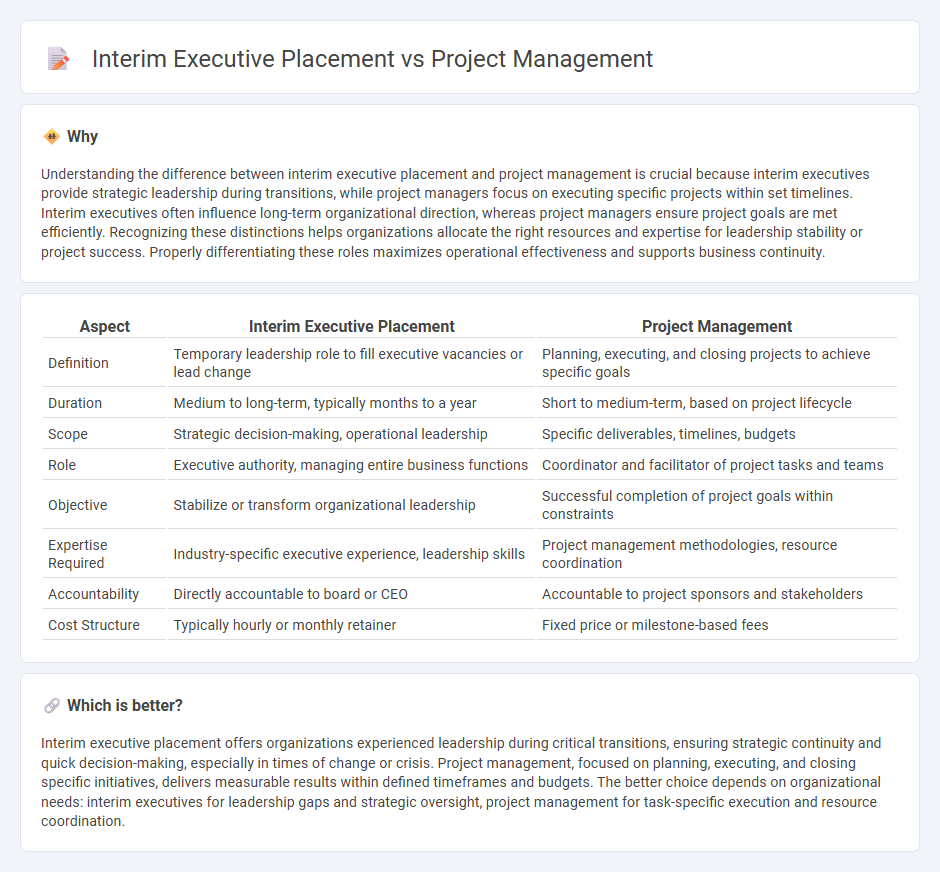
Interim executive placement focuses on assigning experienced leaders to fill temporary high-level roles during transitions or crises, ensuring strategic continuity and decision-making expertise. Project management centers on planning, executing, and closing projects efficiently to meet specific objectives within set timelines and budgets. Explore the distinct advantages and applications of interim executive placement versus project management in your organization.
Why it is important
Understanding the difference between interim executive placement and project management is crucial because interim executives provide strategic leadership during transitions, while project managers focus on executing specific projects within set timelines. Interim executives often influence long-term organizational direction, whereas project managers ensure project goals are met efficiently. Recognizing these distinctions helps organizations allocate the right resources and expertise for leadership stability or project success. Properly differentiating these roles maximizes operational effectiveness and supports business continuity.
Comparison Table
| Aspect | Interim Executive Placement | Project Management |
|---|---|---|
| Definition | Temporary leadership role to fill executive vacancies or lead change | Planning, executing, and closing projects to achieve specific goals |
| Duration | Medium to long-term, typically months to a year | Short to medium-term, based on project lifecycle |
| Scope | Strategic decision-making, operational leadership | Specific deliverables, timelines, budgets |
| Role | Executive authority, managing entire business functions | Coordinator and facilitator of project tasks and teams |
| Objective | Stabilize or transform organizational leadership | Successful completion of project goals within constraints |
| Expertise Required | Industry-specific executive experience, leadership skills | Project management methodologies, resource coordination |
| Accountability | Directly accountable to board or CEO | Accountable to project sponsors and stakeholders |
| Cost Structure | Typically hourly or monthly retainer | Fixed price or milestone-based fees |
Which is better?
Interim executive placement offers organizations experienced leadership during critical transitions, ensuring strategic continuity and quick decision-making, especially in times of change or crisis. Project management, focused on planning, executing, and closing specific initiatives, delivers measurable results within defined timeframes and budgets. The better choice depends on organizational needs: interim executives for leadership gaps and strategic oversight, project management for task-specific execution and resource coordination.
Connection
Interim executive placement ensures organizations have experienced leadership during transitional periods, directly supporting project management by providing strategic oversight and decision-making expertise. Effective interim executives align project goals with business objectives, facilitating resource allocation, risk management, and stakeholder communication. This synergy accelerates project success and maintains operational continuity in dynamic environments.
Key Terms
**Project management:**
Project management involves planning, executing, and closing projects to achieve specific goals within set timelines and budgets, often utilizing methodologies like Agile or Waterfall for optimized workflow. Key performance indicators (KPIs) such as project completion rate, scope adherence, and stakeholder satisfaction are critical for measuring success. Discover more about how strategic project management drives organizational efficiency and innovation.
Scope
Project management centers on delivering specific objectives within defined timelines and budgets, ensuring clear scope boundaries and measurable outcomes. Interim executive placement involves temporarily filling leadership roles to address strategic gaps, often with a broader and more fluid scope aligned with organizational transformation. Explore the distinct scope advantages of each approach to determine the best fit for your business needs.
Timeline
Project management delivers targeted outcomes within a fixed timeline, ensuring milestones and deadlines are met efficiently through structured planning and execution. Interim executive placement provides seasoned leadership for short-term, strategic roles, allowing organizations to navigate transitions or crises without long-term commitments. Explore how aligning your timeline needs with these approaches can maximize operational success.
Source and External Links
Why Is Project Management Important? | National University - Project management is the process of planning, organizing, and overseeing projects to ensure they are completed on time, within budget, and to the expected quality, while also managing risks and keeping stakeholders informed.
What is project management? - APM - Project management applies processes, methods, skills, and experience to achieve specific objectives within agreed parameters, focusing on delivering a final product within a finite timescale and budget, distinct from ongoing management.
Project Management [Definition & Best Practices] | The Workstream - Project management uses skills, tools, and techniques to plan, execute, monitor, and complete projects within predefined timeframes, ensuring work aligns with goals and meets success criteria under given constraints.
 dowidth.com
dowidth.com